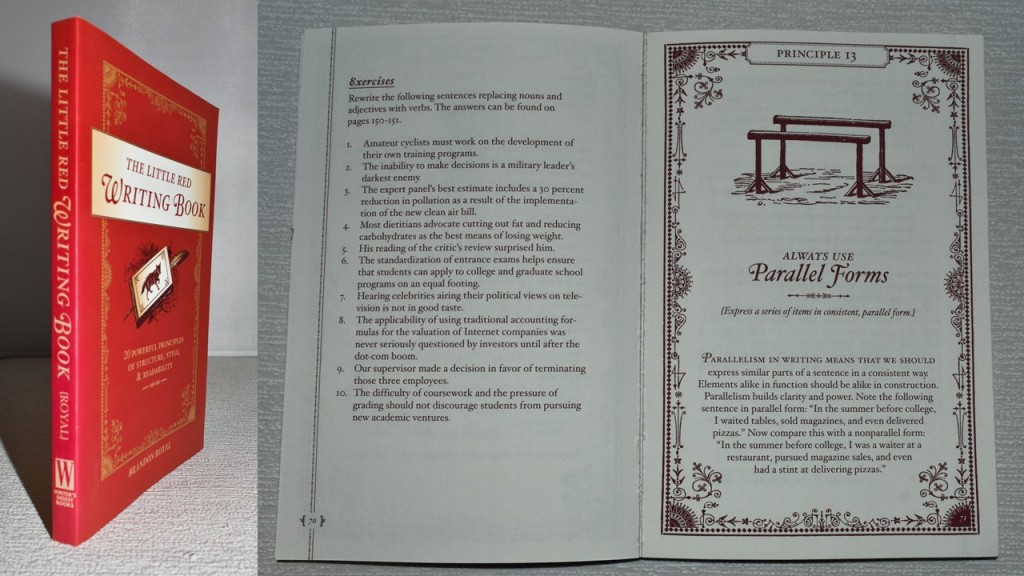
Continuing the description of books on words and language listed in the introductory post, which you’ll find here.
Book 31: The Little Red Writing Book
Paperback, 160 pages. Published in 2007 by Writer’s Digest Books. This is the edition I own and I can’t recall what I paid for it. You can buy it new in paperback for £6.97, used from £3.19 and in a Kindle version for £7.99.
Subtitled ‘20 Powerful Principles of Structure, Style, & Readability’ it sets out to help writers improve their work by applying what the author names as four pillars of the craft. ‘Writing has four pillars – structure, style, readability, and grammar – and each pillar is like the single leg of a sturdy chair.’ I find that an interesting analogy; who wants to sit on a wonky chair, after all?
Opened at random at pages 70/71, I come upon a set of exercises related to Principle 12 ‘Favor Verbs, Not Nouns’. Each of the twenty principles is followed by a set of exercises aimed at consolidating the information provided. And, for this principle, these exercises consist of 10 sentences where the student/reader is required to replace nouns with verbs (don’t worry, answers are provided at the back of the book for those unsure of how to do this!). ‘1. Amateur cyclists must work on the development of their own training programs. Corrected to: Amateur cyclists must work to develop their own training programs.’
Page 71 begins Principle 13, which is: ‘Always Use Parallel Forms’. It goes on to explain what is meant by this instruction, and shows how it will help improve your writing style by giving examples, and then providing another 10 samples as exercises.
It’s a useful little book, and deals with some basic skills that many writers seem unaware of if their output is any guide. I recommend it to all who wish to write as well as they are able.
English is a complex language, made up of words from many countries, and borrows rules of grammar, punctuation and even style from the originating lands, which can make it interestingly familiar to learners but also frequently frustratingly baffling to the same students.
Those learning the English Language will find help on pronunciation here. And you’ll find a friendly group on Facebook through this link.
And, for those with a real interest in English and considering their future, here’s a link that suggests the many possible career opportunities open to those with a degree in the subject. It’s also a link to an online university, and therefore an advert for their services. I know nothing of the institution, but the list of possible career choices might be useful.
Earlier posts in the series can be found by clicking on the titles below.
2. A Dictionary of Misunderstood Misused Mispronounced Words.
3. A Dictionary of Slang and Unconventional English.
4. A Miscellany for Word Lovers.
5. AMERICAN ENGLISH ENGLISH AMERICAN.
6. A Dictionary of Rhyming Slang.
7. Brit-think, American-think.
8. Bryson’s Dictionary for Writers and Editors.
9. Collins English Dictionary.
10. Current English Usage.
11. Descriptionary; a Thematic Dictionary.
12. Divided by a Common Language.
13. Eats Shoots & Leaves.
14. English Prepositional Idioms.
15. Fowler’s Modern English Usage.
16. Hart’s Rules for Compositors and Readers.
17. Hartrampf’s Vocabulary Builder.
18. i before e (except after c).
19. Longman Companion to English Literature.
20. New Hart’s Rules.
21. New Nuttall Dictionary of English Synonyms and Antonyms.
22. Oxford Compact Thesaurus.
23. Oxford Dictionary of Current Idiomatic English.
24. Roget’s Thesaurus.
25. Shorter Oxford English Dictionary.
26. The Dictionary of Diseased English.
27. The Elements of Style.
28. The Emotion Thesaurus.
29. The Grouchy Grammarian.
30. The Last Word.
‘Likes’ are lovely, and appreciated, but shares to platforms such as Twitter, Facebook, etc are more productive in spreading the word. Thank you!


